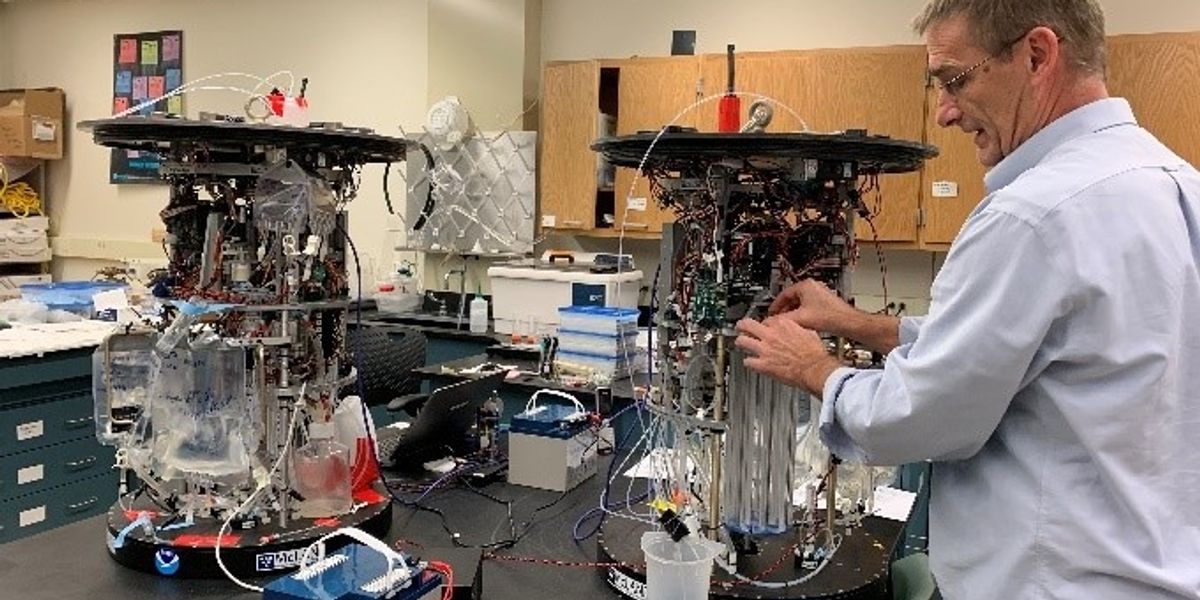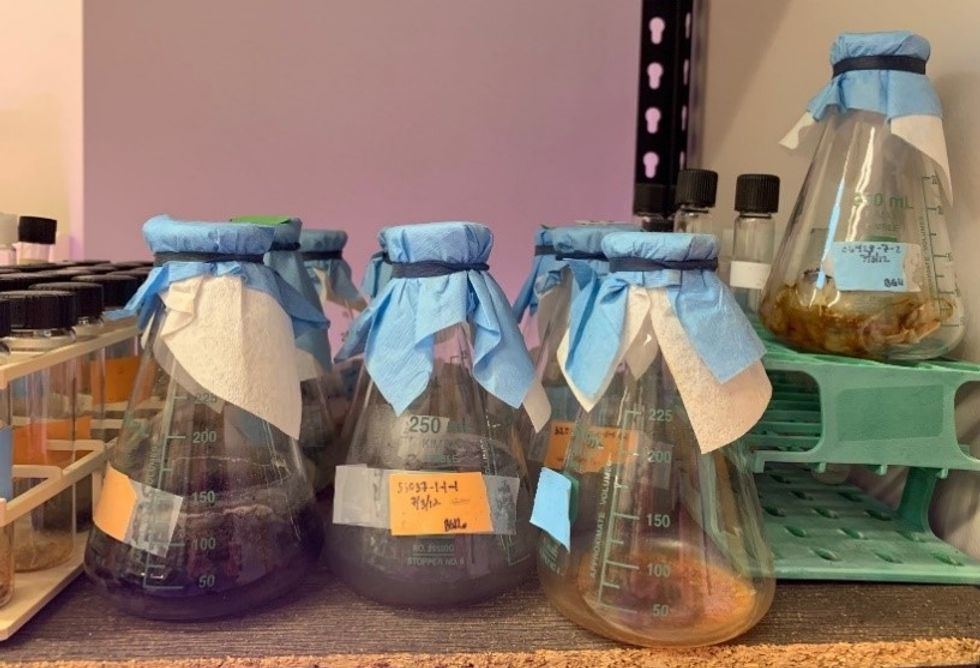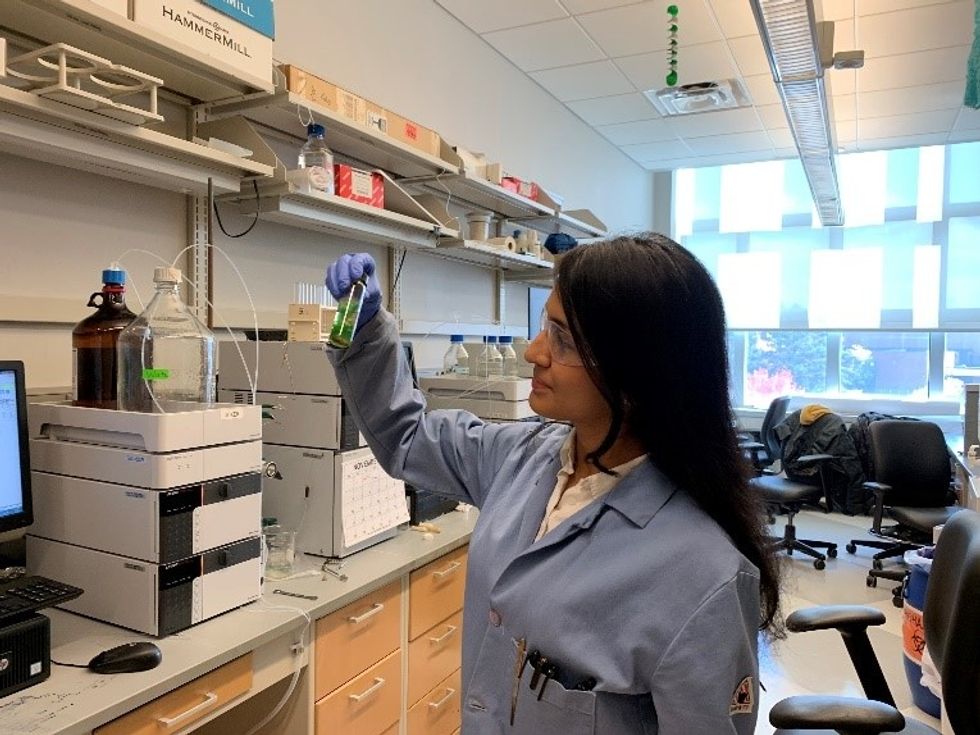
A remedy for harmful algal blooms? Scientist thinks he's found one
"We're going to see cleaner water and we're going to see it at a large scale. It will work"
Covering the entire 40 acres of Lake Newport was a thick, green mat of algae. Looking across the lake in Youngstown, Ohio, last September, Peter Moeller, a government researcher, wondered if his experimental treatment could heal the lake by removing the toxin-producing cyanobacteria.
In the sweltering heat, beads of sweat dripped down the faces of Moeller and his team as they positioned four units of nanobubble ozone generators around the lake shore.
Each unit looked like two boxes, roughly three feet long and wide, and was powered by an electric generator. Wearing waders, the crew arranged the tubes stretching from the generators to the lake. Soon, white streaks appeared in the water as the ozone-filled bubbles entered and broke down the algae.
After the machines ran for five days straight, the lake was crystal clear and returned to its natural state.
"The fish were active, and it was awesome, you couldn't have asked for a better scene," Moeller said.
Moeller is a National Oceanic and Atmospheric Administration scientist based in South Carolina at the Hollings Marine Laboratory. He is using nanobubble ozone technology (NBOT) as a promising new approach to address harmful algal blooms, which are overgrowths of toxin-producing algae.
A global increase in algal bloom intensity has occurred over the past 40 years, according to a 2019 Nature study. The authors, researchers at Stanford and NASA, believe rising temperatures and increased nutrient input, like nitrogen and phosphorous, may be responsible.
In 2017, one of the Stanford authors determined that increased precipitation due to climate change will increase nutrient input in water by about 19 percent for the United States in the 21st century.

The toxic algae are dangerous because it is impossible to distinguish from harmless algae by eye. According to the Centers for Disease Control and Prevention, coming into contact or breathing in the aerosolized toxins can lead to skin, respiratory, and neurological issues.
In addition to impacting recreational activities, such as swimming and fishing, harmful algal blooms can contaminate food and water sources. In 2014, more than 400,000 Toledo, Ohio, residents were ordered not to use their water because of Lake Erie's algal bloom.
Moeller has been a lead toxin chemist for more than 25 years. He has also appeared in the news in 2007 and 2013 for his work identifying and characterizing new toxins that pose environmental and health threats.
His plans to bubble ozone through algae-infested lakes has attracted both supporters and skeptics.
"There is much to learn in respect to the health of fish and other aquatic life and their relationship to this material, as well as refining the techniques of dosing systems," said Tim Wood, President of Society of Lake Management Professionals.
Still, Nick Derico, natural resources steward in Youngstown who witnessed the Lake Newport ozonation, said of NBOT, "I'm definitely hopeful for the future, as I'm sure we'll be seeing more of it."
Municipal water treatment plants often use chemicals to treat algal blooms, such as copper sulfate and aluminum sulfate, or alum.

According to Kelly Frey, head of the Ohio Ottawa County Sanitary Engineering Department, these practices have downsides. Copper sulfate kills cyanobacteria, but simultaneously induces toxin release. Aluminum sulfate precipitates and builds up at the bottom of lakes, harming animals.
Water treatment plants and private well owners have used ozone as a disinfectant, too, but using it to clean entire lakes is new.
To treat lakes with ozone, Moeller is using a combination of NBOT machines that take in oxygen from the air, generate ozone, and release ozone filled nanobubbles into the water.
Since nanobubbles do not float, the bubbles remain underwater and release ozone, a strong oxidant that damages the cell wall of algae and breaks down the chemical bonds of their toxins.
However, Moeller said NBOT is safe for humans and fish because researchers add ozone only at concentrations targeting microbes and not larger.
"Fish are running into natural ozone in far greater concentrations," said Moeller, "and we know that if values are below certain bars, nothing else will be affected."
In other words, he said not enough ozone is added to remove all toxic organisms or beneficial phytoplankton, but enough ozone is added to reduce the amount of harmful algae to much lower levels that make the microorganisms less of a threat to people.
Furthermore, ozone breaks down into oxygen and improves water quality by replenishing the oxygen stolen from animals by algae. "NBOT provides a green, longer term solution," said Moeller, but will need to be reapplied until the decades of nutrient run-off in lakes is decreased.
So far, Moeller's work has cleaned Florida's Port Mayaca Lock and Dam last August and Ohio's Lake Newport last September.
To safely put NBOT on the market, Moeller partnered with Green Water Solutions, LLC, a water purification company using nanobubble technology, through a Cooperative Research and Development Agreement.
The company administered NBOT for free, to test the technology's potential, both at Lake Newport and at Port Mayaca. For the Lake Newport test, Derico, Youngstown natural resource manager, confirms no lake animals were harmed and the algae subsided but said the couple inches of rainfall and constant flux of lake water should be considered.
Chas Antinone, Jr., President of Green Water Solutions, said the preliminary results show significant reductions of algae, toxins, and nutrient levels for both test sites.
With the promising effects of NBOT, Florida is keen on trying NBOT in the St. Lucy River and Ohio in Grand Lake St. Marys. India and the Netherlands are also interested. This year, Moeller has given a lecture in Ft. Lauderdale, FL to the National Algae Association and in Toledo, Ohio, for water treatment managers. Moeller's next goal is to scale up the technology to treat larger bodies of water, like Lake Erie. He is using several government and private funding sources. However, others involved with water treatment and harmful algal blooms are unsure of whether treating Lake Erie with NBOT is a good idea.

"I'm skeptical because so many things have been tried and never worked, so I would like to see the data in operation on that scale first," said Pam Taylor, a full-time volunteer for the Environmentally Concerned Citizens of South Central Michigan.
"I'm all for anyone who can figure it out, but we need to ask how easy it can be applied to 10,000 square miles," said Frey, of Ottawa County Sanitary Engineering. Though, he acknowledges not all of Lake Erie may need to be treated.
"Dumping tons of alum into the lake is going to be just as bad as the blooms themselves," said Nathan Manning, research scientist for the National Center for Water Quality Research at Heidelberg University. "So, if they can figure out something that is nontoxic and environmentally neutral, that'd be great."
"If it is effective at removing the nutrients, the fuel for cyanobacteria, then I think it could be scaled up and work," said Heather Raymond, former Harmful Algal Bloom Coordinator for the Ohio Environmental Protection Agency (EPA) and current Water Quality Research Initiative director for Ohio State University.
To her, the potential benefits of NBOT are clear, but more research is needed before testing Lake Erie. She also predicts the cost of using NBOT on Lake Erie will be as high as any other method. She estimates that one treatment could be millions of dollars, depending on factors, such as ozone dose, flow of water, and amount of water treated.
Currently, Moeller is waiting for permission from the Ohio, Michigan, and Minnesota state department EPAs to begin working on Lake Erie. Although it may take multiple treatments, he is confident NBOT can solve the problem of harmful algal blooms.
By placing larger NBOT machines on barges and moving up and down the lake as a tractor would in a field, he believes all of Lake Erie's water can be improved.
"We're going to see cleaner water and we're going to see it at a large scale," Moeller said, "it will work."
Natalie McMyn is a senior at the University of Michigan with a major in biomolecular science and minor in writing. She has nearly four years of research experience in the biomedical sciences.














